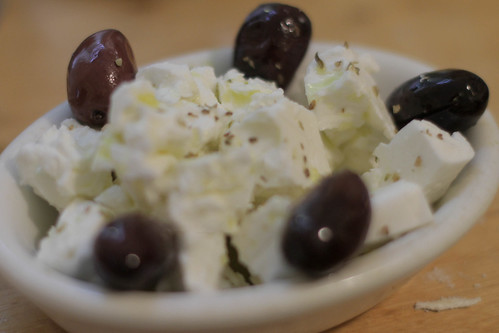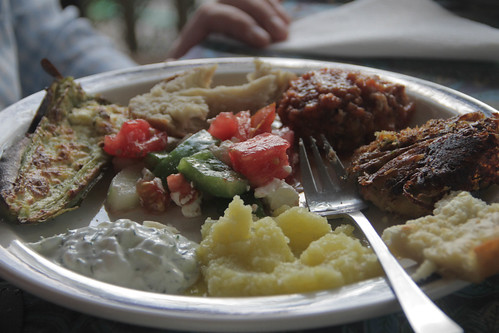
Greece has seen myriad civilizations, invaders, and influences over the millennia, and a climate in which most anything can grow, all of which have contributed to a cuisine that is both abundantly flavored and for the most part extremely healthy. It's also built to be sampled in abundance, with a wide range of mezedes for nibbling and sharing. Fortunately, most of these dishes didn't need to be served piping hot, which made it a little less insane to prepare ten dishes in a medium-sized kitchen with one helper (thanks so much, Neil!).

Our setting for this Nosh certainly encouraged relaxed enjoyment of the Earth's bounty: the porch of our friends' home in Asbury Park, on the Jersey Shore, on a very pleasant summer evening (thanks so much, Jenifer and Phil!).
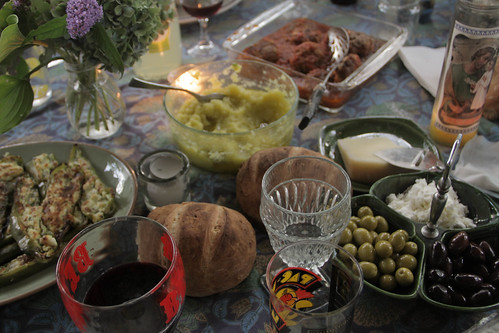
Fasolada | Bean and vegetable soup | Recipe
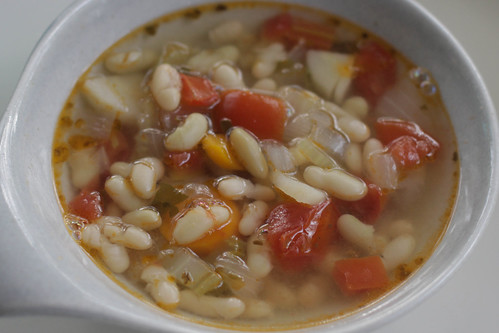
In our culinary journey through time, this humble vegan soup of beans and vegetables brings us both to the very beginning and the most recent days of the history of this part of the world. The Minoan civilization, which preceded the Greeks, grew legumes -- this soup, save for a few New World additions such as tomato, is pretty much their direct legacy. Nowadays, with the Greek economy in a shambles, this soup is as popular as ever, as a big pot is cheap to make and fills the family's stomach. The flavors are simple, with few seasonings or fancy techniques to hide the true flavor of the ingredients, so if you're making this dish as a matter of recreation, make sure to get high-quality beans and vegetables, and take your time simmering to draw out the flavors.
While fasolada is considered by many to be the national dish of Greece, I don't know if I've ever seen it at a Greek restaurant; I've only known avgolemono, the egg-lemon soup that nursed me back from many a college hangover. Why is such a common dish, about which so many Greek food blogs tell deep stories, barely seen on menus of Greek restaurants in the US?
Horiatiki salata | Country salad | Recipe
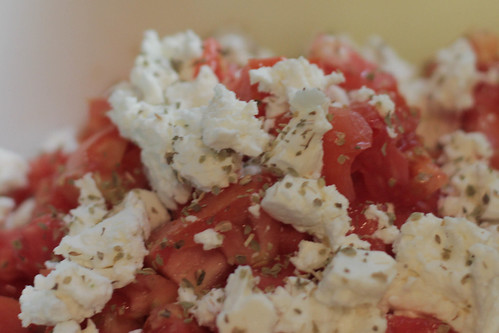
Unlike the soup, this classic Greek salad is known around the world. The real version, apparently, has no vinegar or lemon juice, it's simply vegetables, feta, and olive oil. This one was pretty good, especially with the farmer's market tomatoes, but unfortunately the cucumber was fairly bitter. (Too bad there was no tartness to balance it out!)
Horiatiko psomi | Country sourdough bread | Recipe
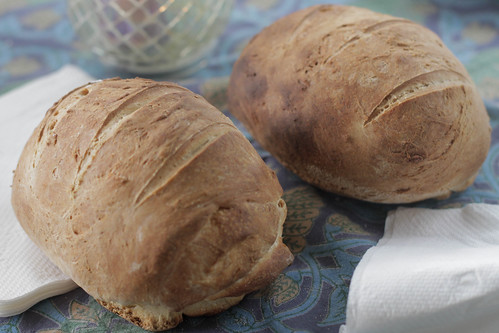
I once read (but can't find again, alas) that a good sourdough starter is so cherished in Greece that saints are invoked during its cultivation, and that despite modern science, many Greek homemakers insist it's a magical, spiritual substance. While I'm all cool with the symbiotic relationship of those yeast and bacteria, to me the magic of Greek bread is the additions of little splashes of milk, honey, and olive oil, which turn mere leavened dough into a springy treat with just enough crunch and tooth to stand up to dipping, spreading, dunking, and straight-up nibbling. The protein and oil make the dough more forgiving to work with, and also crisp up more impressively in a standard home oven. Noted for future baking! Since our hosts weren't going to make bread anytime soon, I figured I should double the recipe, and use the whole five-pound sack of bread flour. By the morning, only one of the five loaves remained.
Skordalia | Garlic potato dip | Recipe
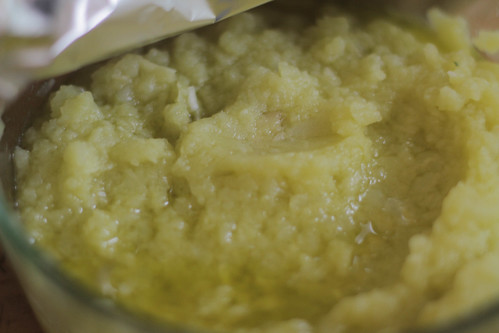
Is this a really garlicky, oily, cold version of mashed potatoes? Or is this a cavalry of garlic (after all, "skorda" means garlic in Greek) hitching a ride on potatoes and oil onto your bread and into your mouth? Either way, it's a surprisingly simple dish to make, and lends itself to endless modification. Creativity, too, because we didn't have a mortar and pestle handy for mashing the garlic, so I put it into a ziploc bag and pounded it a few dozen times with an empty wine bottle. Just don't freak out about all the olive oil in the recipe. If you've got good quality stuff, it'll really make the dip sing.
Alevropita | Feta-olive oil tart | Recipe
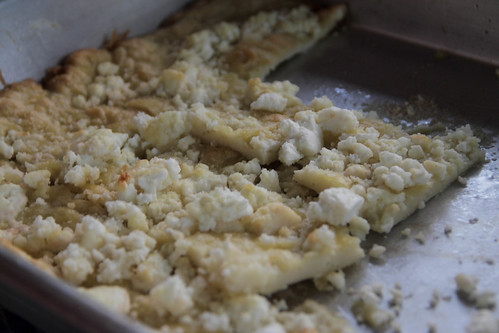
From the northwestern reaches of the country comes this dish that's equal parts simple, tasty, and ridiculous. If you can make pancake batter from scratch, you've already got more than enough skill to put this together. If you like feta and flatbreads and the taste of olive oil, you'll eat the whole pan. And with nearly a half a cup of olive oil and a quarter-stick of butter with a little more than a cup of flour, you'll probably be half grinning and half cringing as you make the dish. Even without the feta this would be a tasty starch halfway to fry dough, but with the cheese, it's just super good.
Piperies gemistes me feta | Feta-stuffed peppers | Recipe
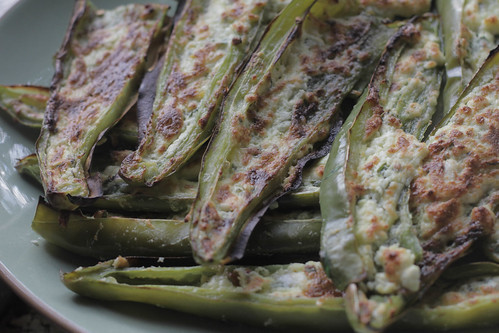
Macedonia, the covering much of the north of Greece (not to be confused with The Former Yugoslav Republic of Macedonia directly to the north), is apparently the most exciting place for food in a country that seems pretty stimulating all over. It's a real convergence location between Balkan, Greek, and Turkish, and also has the legacy of a once-sizable Jewish community. These peppers themselves mark a convergence of spicy, creamy, and toasty, making use of the broiler twice: once to soften the peppers, and another to heat the cheese filling to brown. Greece is, of course, a wine country, but if you ever need a Greek dish that goes well with beer, look no further.
Kolokitho keftedes | Zucchini fritters | Recipe

Crete, the largest of the Greek islands, is the home of what is essentially a latke (i.e., potato pancake), but made instead of zucchini. Poor Neil spent upward of an hour shredding by hand the two largest zucchini I'd ever seen in my life, along with onion, carrot, and other ingredients. And all that yellow in the photo? That's extra virgin olive oil, in abundance. The fritters were darn good, especially accompanied by the tzatziki I whipped up (Greek yogurt, shredded cucumber and garlic, mint, salt, done). The only problem with making them for a crowd is that you're spending valuable minutes right around service time standing impatiently around a skillet, waiting for them to cook -- out of all the dishes we made, this is the only one that held up our starting at the appointed hour.
Keftedes me saltsa domata | Lamb meatballs in tomato sauce | Recipe
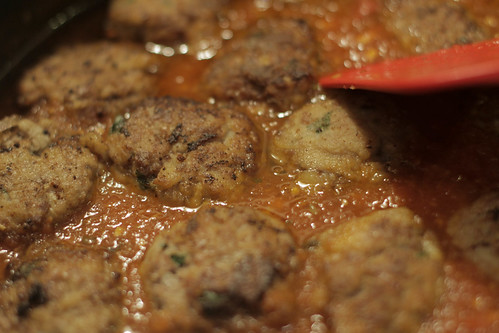
"What do you do with this stuff?" asked the butcher at Fairway while handing me the ground lamb. "I had it once at an Arab stand and it was weird." Well, dear friend who doesn't enjoy what he's selling, you might enjoy this dish as a re-introduction to the other red meat. The lamb is first blended with spices, especially the ever-present oregano, then fried as little meatballs, and finally nestled in with a tomato sauce -- which I made from fresh tomatoes from the farmers market rather than canned. This one was a winner, especially with the little kids!
Karithopita | Olive oil walnut cake | Recipe
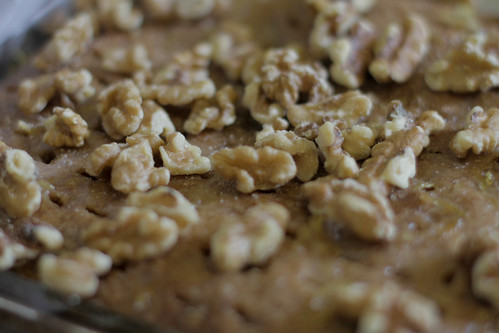
For what the EU called its 50th birthday, the anniversary of the signing of the Treaty of Rome, all its members sent two cakes representative of their national cuisines. This is one of the two Greece sent. The cake starts out rich enough, with a cup of olive oil, lots of walnuts, and semolina and cake flours. But the real treat comes when it's drenched in a lemony syrup -- so much so that you have to pour it a third at a time to make sure it all absorbs. Not too hard to make, and really nice, would make for an excellent coffee cake and is also great with a dollop of Greek yogurt.
Galaktoboureko | Milk custard phyllo cake | Recipe
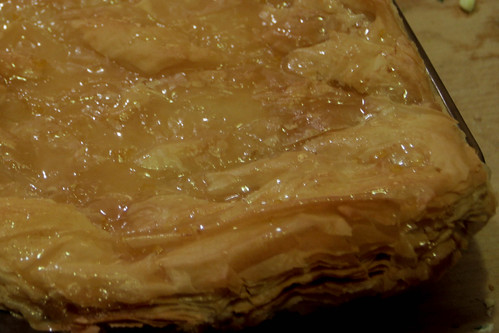
I've already made baklava for Armenia, but I felt the need to make something with that flaky phyllo dough for this meal. Behold this amazing pastry, made of an astonishing 10 cups of milk, seven eggs, and a half pound of butter. As long as you're patient and attentive with the stirring, it's actually pretty easy to make, and it's really tasty, a little more subtle and less heavy than baklava. The only tweak I made was to replace about half of the sugar and water in the syrup with honey, which I would definitely do again. The Ottoman influence on Greek cuisine is clear here: "boureko," meaning stuffed pastry, comes from the Turkish "börek."
